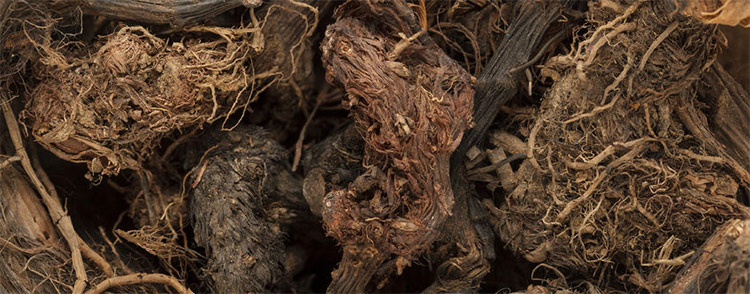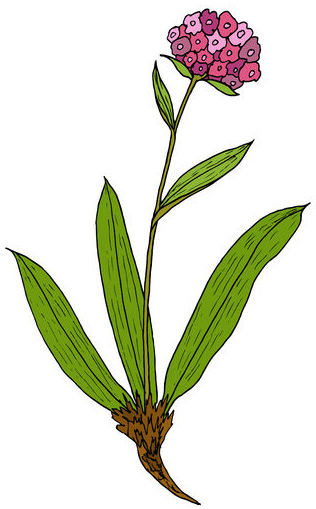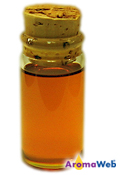Spikenard Essential Oil
Nardostachys jatamansi

Description
Spikenard Essential Oil is also known as Jatamansi Essential Oil. The botanical is also known as Nard and Muskroot.
Spikenard Essential Oil is produced by steam distilling the roots of Nardostachys jatamansi, a flowering botanical that grows wild in the Himalayas.
Generally speaking, Spikenard Essential Oil contains approximately 50% Sesquiterpenes, 10-15% Sesquiterpenols and 5% Aldehydes. Vetiver Essential Oil also contains levels of Sesquiterpenes and Sesquiterpenols within these approximate ranges.

Aromatically, Spikenard Essential Oil is very deep, rich, earthy and woody. I love Vetiver Essential Oil, and the two are somewhat similar in aroma. However, Spikenard Essential Oil is not as smoky smelling (and the Spikenard Essential Oils that I've worked with are not as thick). Some refer to Spikenard Essential Oil as having an "animalistic" aromatic subtly to it.
I love the aroma, but tend to use it sparingly in blends as to not overpower the aroma of other essential oils and because it is endangered (see below). It blends well with many other essential oils including those in the wood, spice, herbaceous and floral families.
For emotional applications, Spikenard Essential Oil is calming and relaxing. It can be useful to include in blends intended to help promote sleep and relaxation.
Spiritually, Spikenard has a very long history. Spikenard Essential Oil is a wonderful essential oil to use for meditation, prayer and other spiritual applications. It is incredibly grounding. It resonates and helps balance the Root Chakra.
Spikenard may be the spikenard aka nard that are referenced within the Old and New Testaments of the Bible. However, a number of plants have gone by similar common names throughout history, so it's not with full certainty that Nardostachys jatamansi that we know today as Spikenard or Jatamansi is the same Spikenard referenced in the Bible.
"Thy plants are an orchard of pomegranates, with pleasant fruits; camphire, with spikenard, spikenard and saffron; calamus and cinnamon, with all trees of frankincense; myrrh and aloes, with all the chief spices:"
— Song of Songs 5:13-14 (KJV)
"Then took Mary a pound of ointment of spikenard, very costly, and anointed the feet of Jesus, and wiped his feet with her hair: and the house was filled with the odour of the ointment."
— John 12:3 (KJV)
I've encountered statements that claim that it was pure, undiluted Spikenard Essential Oil that Mary used to anoint and pour over Jesus' feet. That is not necessarily true. It was much more likely that a beautiful anointing oil was made by infusing spikenard roots into olive oil or another lipid was used. For more information regarding how anointing oils and fragrant oils were made during Biblical times, read AromaWeb's article Aromatic Botanicals, Aromatherapy and the Bible.
Spikenard Essential Oil Sustainability Concerns
Spikenard is critically endangered. Over-harvesting of Spikenard for use in the production of Spikenard Essential Oil is responsible for causing greater endangerment to this revered plant. Whenever possible consider using and purchasing alternate essential oils to use in place of endangered Spikenard Essential Oil. Vetiver Essential Oil is a possibility. When purchasing Spikenard Essential Oil, ensure that you are purchasing it only from a reputable supplier that focuses upon the legal sourcing and sustainability of Spikenard. For more information about the circumstances, read Tisserand Institute's article Spikenard and Sustainability. Also refer to the "Sustainability and Conservation Status" section below.
Spikenard Essential Oil Benefits and Uses
- Insomnia
- Menstrual Problems
- Muscular Spasm
- Muscular Contractions
- Neuralgia
- Sciatica
- Bodily Congestion
- Aging Skin
- Physical Tension
- Stress-related Conditions
- Anxiety
- Nervous Tension
- Soothing
- Calming
Source: Valerie Ann Worwood, The Complete Book of Essential Oils and Aromatherapy, 25th Anniversary Edition (Novato, CA: New World Library, 2016, 623.
Botanical Name
Plant Family
Common Method of Extraction
Steam Distilled
Plant Part Typically Used

Color
Pale Amber to Amber or Greenish-Amber in Color
Consistency
Medium
Perfumery Note
Base
Strength of Initial Aroma
Medium
Aromatic Description
Spikenard Essential Oil smells deep earthy, woody and musky.
Sustainability and Conservation Status
Critically Endangered
Source: https://www.iucnredlist.org/species/50126627/50131395
To learn more about the conservation status of essential oil bearing plants and how to use the IUCN Red List of Threatened Species, please refer to AromaWeb's Guide to Essential Oils and Sustainability.
Major Constituents
- Nardol
- Formic Acid
- a-Selinene
- Dihydro-B-ionone
- Nardol Isomer
- Selinene Isomer
- Propionic Acid
- B-Caryophyllene
- Cubebol
Source: V.S. Mahalwal, M. Ali. Volatile Constituents of the rhizomes of Nardostachys jatamansi DC. (Journal of Essential Oil Bearing Plants 5, 2002), 83-89. Source cited in Robert Tisserand and Rodney Young, Essential Oil Safety (Second Edition. United Kingdom: Churchill Livingstone Elsevier, 2014), 428-429.
Spikenard Essential Oil Safety Information
Tisserand and Young do not indicate any special precautions when using Spikenard Essential Oil. Reading Tisserand and Young's full profile is recommended. [Robert Tisserand and Rodney Young, Essential Oil Safety (Second Edition. United Kingdom: Churchill Livingstone Elsevier, 2014), 428-429.]
General Safety Information
Do not take any oils internally and do not apply undiluted essential oils, absolutes, CO2s or other concentrated essences onto the skin without advanced essential oil knowledge or consultation from a qualified aromatherapy practitioner. For general dilution information, read AromaWeb's Guide to Diluting Essential Oils. If you are pregnant, epileptic, have liver damage, have cancer, or have any other medical problem, use oils only under the proper guidance of a qualified aromatherapy practitioner. Use extreme caution when using oils with children and be sure to first read the recommended dilution ratios for children. Consult a qualified aromatherapy practitioner before using oils with children, the elderly, if you have medical issues or are taking medications. Before using this or any essential oil, carefully read AromaWeb's Essential Oil Safety Information page. For in-depth information on oil safety issues, read Essential Oil Safety by Robert Tisserand and Rodney Young.
Shelf Life
Important Information About the Profiles
The essential oil information provided on AromaWeb is intended for basic educational purposes only. The references to safety information, test results, constituents and percentages is generalized information. Essential oils can vary greatly in composition. The data is not necessary complete and is not guaranteed to be accurate. The essential oil photos are intended to represent the typical and approximate color of each essential oil. However, essential oil composition and color can vary based on harvesting, distillation, age of the essential oil and other factors. Profiles for several CO2 Extracts and absolutes are included within the directory, and are denoted as such.
